|
Easter Eggs
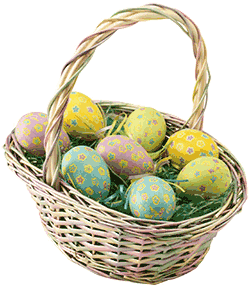
Dear Readers,
In April, Christians all over the world are celebrating Easter, one of their favourite holidays.
Easter is probably the only religious holiday which was celebrated in the USSR even in Soviet times.
In most families, there were grandmothers and old aunties who would bake ‘kulichi’ and they would dye eggs different colours. I remember what a great treat it was for children and grown ups too. But they were not mere tasty things, they were symbols of the holiday.
Next to the column you will find some material about the Easter symbols written by our permanent author David Wright.
Nadezhda
by David Wright
Easter is the Christian festival celebrating the story of Jesus Christ’s crucifixion1 and, especially, his resurrection2. However, like much else in this modern age, the religious significance of that festival has diminished and been overtaken (in the West at least) by rampant3 commercialism.
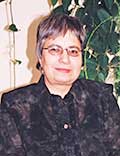 Надежда Никифоровна Рогожина
Надежда Никифоровна Рогожина, проректор по международным программам, зав. кафедрой лингвистики и межъязыковой коммуникации Самарского муниципального университета Наяновой, кандидат педагогических наук, доцент.
Директор негосударственного учреждения дополнительного образования “World Class-Samara”.
The emergence of a chick from an egg is a graphic analogy of life from the dead. It has been used by all the various Christian traditions, Orthodox, Roman Catholic and Protestant, throughout the ages to teach (particularly) children the story. However, this potent symbol long predates4 Christianity. The egg is nature’s perfect package. Decorated eggs are much older than Easter. They have represented mystery, magic, medicine, food and omen5 since long before they became closely entwined6 with the Christian Easter. The practice was honoured during many rite-of-Spring festivals; Romans, Gauls, Chinese, Egyptians and Persians all cherished7 the egg as a symbol of the universe. From ancient times eggs were dyed, exchanged and shown reverence8.
In Pagan times, the egg often represented the rebirth of the earth. The long, hard winter was over; and the earth burst forth9 and was reborn just as the egg miraculously burst forth with life. The egg, therefore, was believed to have special powers. It was buried10 under the foundations of buildings to ward off11 evil; Roman women carried an egg on their persons to foretell12 the sex of their unborn children; French brides stepped upon an egg before crossing the threshold of their new homes.
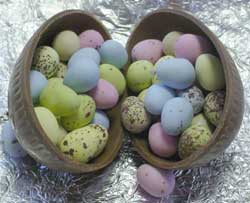
Chocolate Easter eggs
Easter eggs are still a popular symbol of new life in Poland and in the folk traditions of other Slavic countries. A batik-like decorating process, known as pisankaI is used to produce intricate, brilliantly-coloured eggs. Look out for the 27-foot (9 m) sculpture of a pisanka in Vegreville, Alberta, Canada, if you are ever passing that way! There are many other decoration techniques and numerous traditions of giving coloured eggs as tokens13 of friendship, love or good wishes.
With the advent of Christianity the symbolism of the egg changed to represent, not nature’s rebirth, but the resurrection of Jesus and the possibility of spiritual14 rebirth for mankind. Christians adopted the image of the egg and likened it to the tomb from which Christ rose. It is now one of the most easily recognised symbols of Easter throughout the world. Nowadays an Easter eggII is the favourite feature of the holidayIII for most children in lands with a Christian culture.
Decorating and colouring eggs for Easter was already the custom in England during the middle ages. The household accounts of Edward I, for the year 1290, recorded an expenditure15 of eighteen pence for four hundred and fifty eggs to be gold-leafed and coloured for Easter gifts.
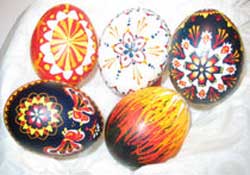
Sorbian Easter eggs
The most famous decorated Easter eggs were those made by the well-known goldsmith16, Peter Carl Fabergй. In 1883, Czar Alexander commissioned Fabergй to make a special Easter gift for his wife, the Empress Marie. The first Fabergй egg was an egg within an egg. It had an outside shell of platinum enamelled white which opened to reveal a smaller gold egg. The smaller egg, in turn, opened to display a golden chicken and a jewelled replica17 of the Imperial crown. This special Fabergé egg so delighted the Czarina that the Czar promptly ordered the Fabergй firm to design further eggs to be delivered every Easter. In later years Nicholas II, Alexander’s son, continued the custom. Fifty-sevenIV eggs were made in all. You can read more about these beautiful eggs and see pictures of some at: http://users.vnet.net/schulman/Faberge/eggs.html
With their well-known love for elaboration, the English Victorians made and gave extravagant artificial eggs, using sugar moulded in intricate designs. Some used paper flowers and leaves, tiny cherubs18, jewels and elegant fabrics, braids and trims, to adorn the eggs. The halves were separated, delicately hinged19 and glued together with transparent cement, then covered with a glossy resin finish20. Although the omens and the mystery of the egg have disappeared today, the symbolism remains and artists continue in the old world tradition of adorning eggs.
In its simpler forms, the Easter egg was just an ordinary hard boiled hen’s egg, painted or coloured by some simple vegetable or other edible21 dye, such as cochineal22, onion skins or beetroot23 juice. Typically, these eggs would be hidden for the children of the family to find in a sort of treasure hunt.
The modern custom is to use chocolate eggs made in different sizes, although you can find some made from plastic and filled with smaller eggs or other sweetsV. Some are delicately constructed of spun sugar24 using pastry decoration techniques.
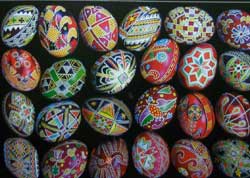
Ukrainian Easter eggs or pysanky
In fact, Easter eggs can be any form of confectionery, not just hollow chocolate eggs and are often wrapped in brightly-coloured metal foil25. A comparatively recent innovationVI here is the Easter Bunny, a baby rabbit who supposedly hides the eggs for children to find on Easter morning.
Easter egg origin stories abound26, but I think it is likely that the Easter egg tradition may have arisen to mark the end of fasting27 during Lent28. In the West, eggs were seen as ‘meat’VII, which would have been forbidden during that time. I believe that in Eastern (Orthodox) Christianity both meat and dairy products were prohibited during the fast and eggs were seen as ‘dairy’VIII products.
A tradition exists in some parts of Britain of rolling painted eggs down steep hills on Easter Sunday although it has been banned in some places now in case anyone falls down the hill and hurts themselvesIX. In the US, such an Easter egg roll may be done on flat ground, pushing the egg along with a spoon – which I suppose is safer. An Easter egg hunt is a common festive activity, where eggs are hidden outdoors (or indoors if in bad weather) for children to run around and find. This may also be a contest to see who can collect the most eggs. I expect you know of other traditions concerning Easter eggs from your part of the world as they seem to be enjoyed almost everywhere in some form or another.
I Or ‘pisanky’.
II I am told that they are also known as ‘Spring eggs’ in the USA.
III Derived from ‘Holy Day’. For much of history in Christendom, the only breaks from daily toil enjoyed by the working man and woman were the days of rest prescribed by the church.
IV Some say 56.
V Called ‘candy’ in the US.
VI I think from the USA, although rabbits are also an ancient fertility symbol.
VII It is said that the EEC, forerunner to the EU, once spent five months trying to decide whether snails were ‘meat’ or ‘fish’. Their report was published in nine languages and concluded that they are ‘fish’.
VIII That is, a foodstuff that could be taken from an animal without shedding its blood.
IX One of many foolish laws and regulations which have been introduced by the government in recent times to try to prevent anyone coming to any harm even at the expense of freedom and enjoyment.
1 crucifixion – распятие
2 resurrection – воскресение (из мертвых)
3 rampant – свирепствующий
4 predate – предшествовать
5 omen – примета
6 entwine – вплетать
7 cherish – (зд.) почитать
8 show reverence – проявлять уважение
9 burst forth – расцветать
10 bury – зарывать в землю
11 ward off – отвращать
12 foretell – предсказывать
13 token – знак, символ
14 spiritual – духовный
15 expenditure – расходование
16 goldsmith – ювелир
17 replica – модель
18 cherub – херувим
19 hinge – прикреплять на петлях
20 finish – полировка
21 edible – съедобный
22 cochineal – кошениль (красная краска из тлей)
23 beetroot – свекловица
24 spun sugar – сахарные волоконца
25 foil – фольга
26 abound – иметься в большом числе
27 fasting – пост
28 Lent – великий пост
Читать еще в этой рубрике:
Читать еще в этом номере:
|
|











